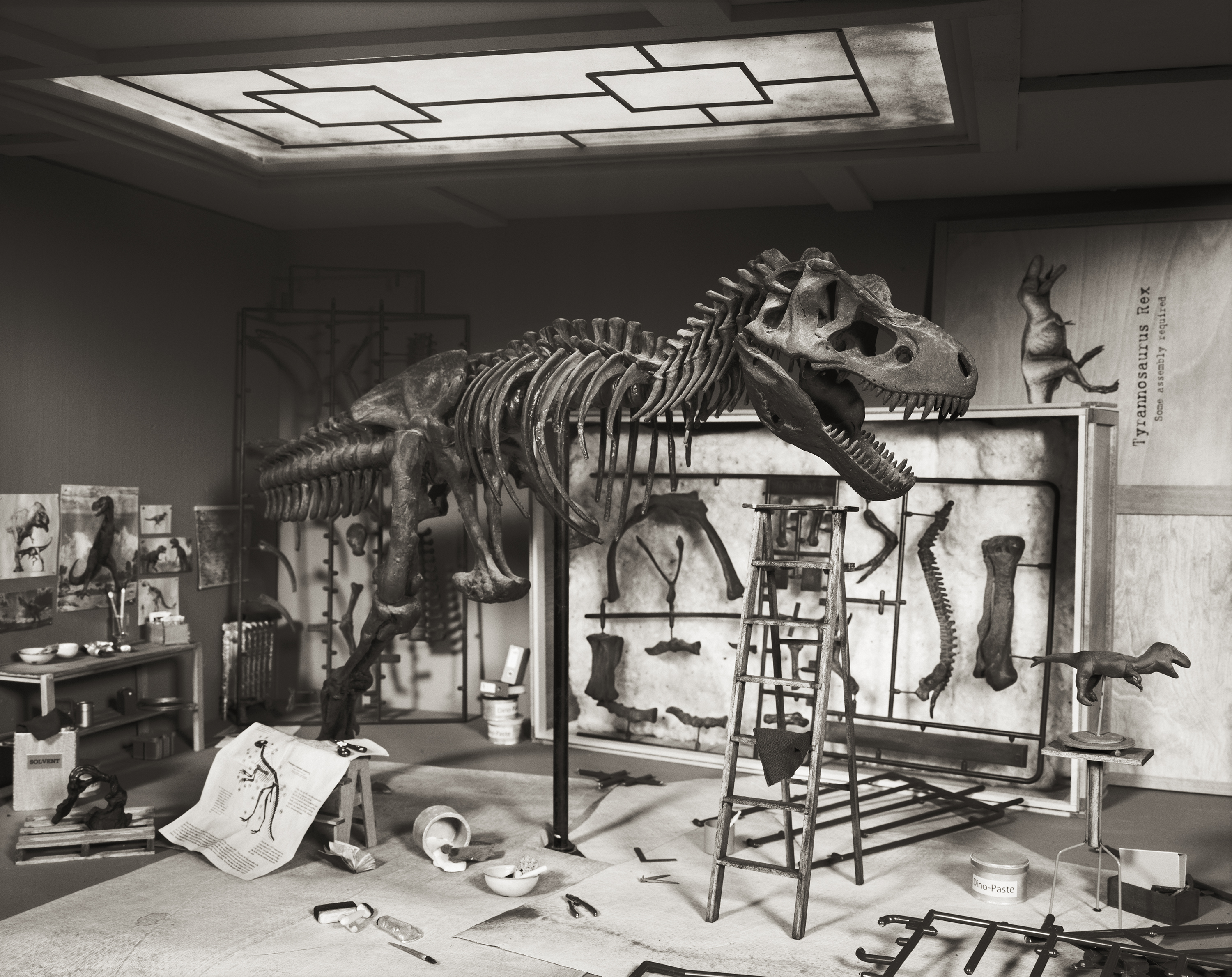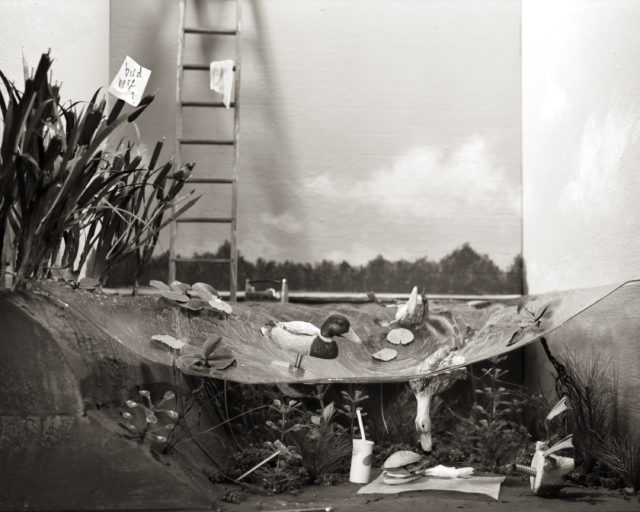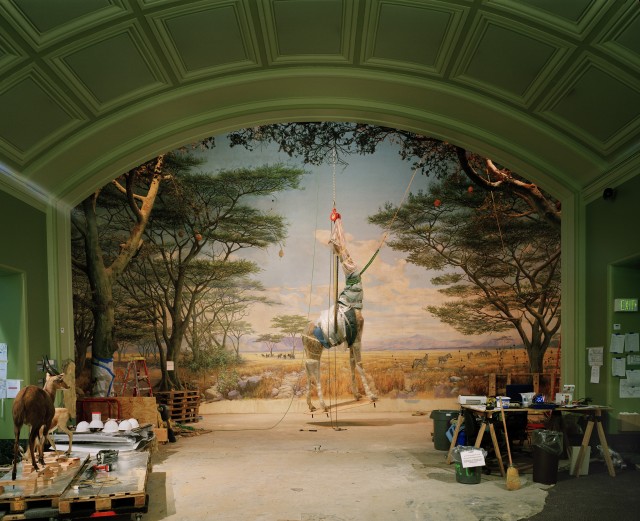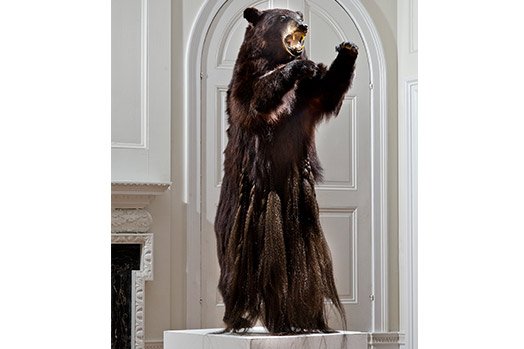
“Recapturing the Scenic Wilds,” an exhibit currently up at Wave Hill in the Bronx, explores the interstitial space between performance and pedagogy in natural history displays. Image: Lori Nix, “T-Rex,” 2010, archival inkjet print 8” x 10,” image courtesy of the artist.
Many of us have stood face-to-face with a lion — gazing through the plate glass of a museum diorama, that is. Planted in front of a natural history display, a museumgoer might feel as if she is actually standing on a dusty desert plain, eyes locked with a gazelle, or shin-deep in fresh snow, close enough to feel the hot breath of a snow leopard.
As we daydream it’s easy to forget that somebody actually had to conceptualize all the details we see: the layout of flora and fauna, the posture of each creature, the overall mood of each scene.
But in fact, natural history displays are as subject to technical error and cultural bias as any other human endeavor. This theme runs through “Recapturing the Scenic Wilds,” an exhibit currently on show at Glyndor Gallery of Wave Hill, a 28-acre estate overlooking the Hudson River in the Bronx.
“Many artists in this exhibit explore how natural history displays balance the roles of education and entertainment,” said David Borgonjon, a curatorial fellow at Wave Hill who helped develop the exhibit. He noted that the exhibit pays homage to one of America’s most theatrical conservationists, Theodore Roosevelt, who once lived at Wave Hill.
Lori Nix, Richard Barnes and Hugh Hayden are among the nine artists whose pieces appear in the exhibit. For many, natural history dioramas evoke the experience of witnessing a wild habitat firsthand, but Nix, Barnes and Hayden know it’s actually more like a secondhand experience — if not third or fourth. Because they are artists, they are used to assessing the motives, conscious or not, that go into visual displays. In a panel discussion at Wave Hill in November, entitled “The Power of Natural History,” they dissected this line between art and actuality in natural history exhibits.
Nix, a photographer, displayed whimsical shots of miniature dioramas-in-progress. With humor, her pieces highlight the mundane aspects behind the construction of such grand spectacles. One photo features an Arctic scene with caribou and wolves — majestic except for the snow machine parked in front of it. A shot of a room filled with taxidermied birds shows a bucket of Kentucky Fried Chicken sitting on the desk. In a pond diorama, half-assembled ducks are strewn about, a sign that sloppily reads “bird here?” tacked on some cattails.

Lori Nix , “Ducks,” 2014, Archival inkjet print, 15˝ x 18.˝ Courtesy of the artist.
Nix said she wanted to explore the mechanics of designing and constructing a natural history diorama — and, in particular, what can go wrong along the way. “As viewers, we believe natural history exhibits have to be real. We’re in a museum, so we have to take these displays seriously,” she said. “My work pokes fun at this idea.”
Barnes’ work is more somber. The exhibit features three pieces from his “Animal Logic” series, which collects photographs from museum displays under renovation. Perhaps the most striking photo is one of a giraffe being lowered by its neck into a diorama at the California Academy of Sciences in San Francisco. It conveys a process that is laborious, and even somewhat violent — the giraffe’s head is wrapped in opaque plastic; its neck, held by a crane, arches backwards with a rope wrapped around its throat.

Richard Barnes , “Suspended Giraffe,” 2005, Digital C-print, 48” x 60.” Courtesy of the artist and Foley Gallery.
Barnes was particularly struck by the idea of scientists going into the field, killing an animal, bringing it indoors and reanimating the corpse on a carefully constructed set. It’s perverse, but exciting, he said. “As an artist interested in artifice and theatricality, this was a point of entry. I wanted to explore how we look at the natural world in these dioramas — how we suspend disbelief.”
Hayden’s work examines how societies attribute certain traits, such as aggression, kindness, regality or wildness, to different animals. On one of John James Audubon’s most famous paintings, “Great American Hen & Young Vulgo Female Wild Turkey,” Hayden overlaid real pigeon feathers to highlight contradicting notions of fantasy and reality towards American wildlife. We celebrate the extinct wild turkey, but scorn the domestic pigeon, which still exists today, he said.
In another piece, Hayden braided the fur of a taxidermied black bear. Reinterpreting the black bear as a symbol of American masculinity, the piece explores what happens when we manipulate the bear’s appearance through an action coded with cultural and social connotations. By feminizing and undermining the aggressiveness of the black bear, the braids challenge our cultural assumptions.

Hugh Hayden , “American Hero #5,” 2014, Braided taxidermy American black bear (Ursus americanus). Photo credit Stefan Hagen.
“A lot of my artwork — whether it uses skin, feathers, tree bark, fur — is interested in manipulating organs of identification,” said Hayden. He drew parallels between our constructed perceptions of animals and the cultural constructs we have within our own society. Practices like braiding and lengthening hair can be a way for people to manipulate their identities, he said.
Borgonjon hopes the exhibit challenges visitors’ understanding of what it means for something to be wild. The example of the domestic pigeon is telling, he said, pointing to how we don’t deem the bird as wild enough to display in a natural history exhibit.
“We often think of cities as constructed, and wilderness as real,” he said. “But much of the art in this exhibit suggests the opposite may be true: We construct artificial ideas of nature, while encountering real instances of wilderness in cities everyday.”